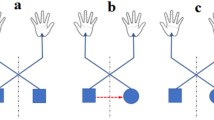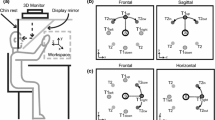Abstract
The purpose of the present experiment was to study the way in which the central nervous system (CNS) represents gravitational force (GF) during vertical drawing movements of the arm. Movements in four different directions: (a) upward vertical (0°), (b) upward oblique (45°), (c) downward vertical (180°) and (d) downward oblique (135°), and at two different speeds, normal and fast, were executed by nine subjects. Data analysis focused upon arm movement kinematics in the frontal plane and gravitational torques (GTs) exerted around the shoulder joint. Regardless of movement direction, subjects showed straight-line paths for both speed conditions. In addition, movement time and peak velocity were not affected by movement direction and consequently changes in GT, for both speeds tested. Movement timing (evaluated through the ratio of acceleration time to total time) changed significantly, however, as a function of movement direction and speed. Upward movements showed shorter acceleration times when compared with downward movements. Concerning the four directions, movements made at 0° and 45° differed significantly from those made at 135° and 180°. Drawing movements executed at rapid speed presented similar acceleration and deceleration times compared with movements executed at normal speed, which showed greater acceleration than deceleration times. In addition, the form of velocity profiles (assessed through the ratio of maximum to mean velocities), was significantly modified only with movement speed. Results from the present study suggest that GF is efficiently incorporated into internal dynamic models that the brain builds up for the execution of arm movements. Furthermore, it seems that GF not only is a mechanical parameter to be overcome by the motor system but also constitutes a reference (vertical direction), both of which are represented by the CNS during inverse kinematic and dynamic processes.
Similar content being viewed by others
Author information
Authors and Affiliations
Additional information
Received: 19 May 1997 / Accepted: 3 November 1997
Rights and permissions
About this article
Cite this article
Papaxanthis, C., Pozzo, T., Vinter, A. et al. The representation of gravitational force during drawing movements of the arm. Exp Brain Res 120, 233–242 (1998). https://doi.org/10.1007/s002210050397
Issue Date:
DOI: https://doi.org/10.1007/s002210050397




